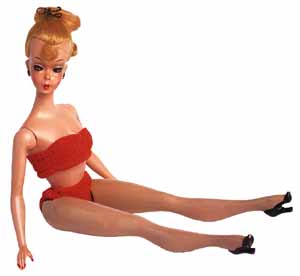|
When I look at women my age, I do not see a group of women warped by Barbie, but a group of women who believe in the power to create a life for themselves. And regarding children of today, we have clearly devalued the role of imagination and the ways in which Barbie broadens, not narrows, play opportunities.
A quick review of most of the literature concerning Barbie focuses on the ways in which Barbie is insufficient or problematic. The articles I read included a look at the self-serving way Mattel has marketed ethnic Barbies (Ducille), the fact that Barbie's body type is likely to occur only in one in one hundred thousand women (Norton), a discussion of the fiasco that occurred on a college campus when Barbie was included on a poster that celebrated "Women In Action" (Chamberlain) and a satirical lament by a writer who was still looking for Jewish Barbie (Lieberman).
By far, the most interesting and definitive treatise on Barbie is M.G. Lord's
Forever Barbie , an overview of the history of Mattel and the marketing of Barbie, as well as a look at how Barbie aficionados operate today. Here we learn that Barbie was created by Ruth Handler, who based her loosely on a sexy (even sleazy) German doll named Lilli originally marketed to men. We learn about the ways Mattel has changed its marketing over the last 38 years, noting some clear successes and some very entertaining failures. Remember "Growing Up Skipper," who developed quite a nice chest when you twisted her arm or "Earring Magic Ken," who wore a lavender vest, an earring in his left ear and a ring pendant? Lord also focuses on the ways in which Mattel has worked to become inclusive and diversified in it's marketing attempts.

The German doll Lilli bears a striking similarity to Barbie.
Overall, Lord's book is entertaining and packed with great information about Barbie's evolution, with definite insight into the phenomenon that is Barbie. My objection to Lord's approach is that she buries Barbie's positive attributes.
Like most feminists, I have been less than enthusiastic Barbie. When asked to purchase Barbies for my nieces, I have wondered if this was really the best gift to give them. Would I be contributing to their eventual battles with bulimia? I also do not have any children, so will never be confronted with the possible psychological damage that I may impart by allowing or denying Barbie mania to take hold. Therefore, my analysis depends in part on conversations with my friends and family about what Barbie means to them.
However, after my fifth trip in two years to the fuchsia Barbie temple of Toy's 'R' Us, I began to notice something I had not noticed before. Barbie has many, many- choices in life, in both career and leisure activities. I discussed this with a friend Laura and she shared that one summer she and her sister had taken their Barbies (in the '60s version of a Barbie motorhome) on a tour of the United States, planned out and executed in the back yard. Each of their Barbies also had detailed educational and job experiences, as well as social histories. Another friend said that she and her friends created entire communities where all the Barbies took on new names, with some Barbies married, some not, some had careers, some did not, some were mothers and some not. In other words, a fairly accurate reflection of the world.
 page 1 of 3
page 1 of 3

|


